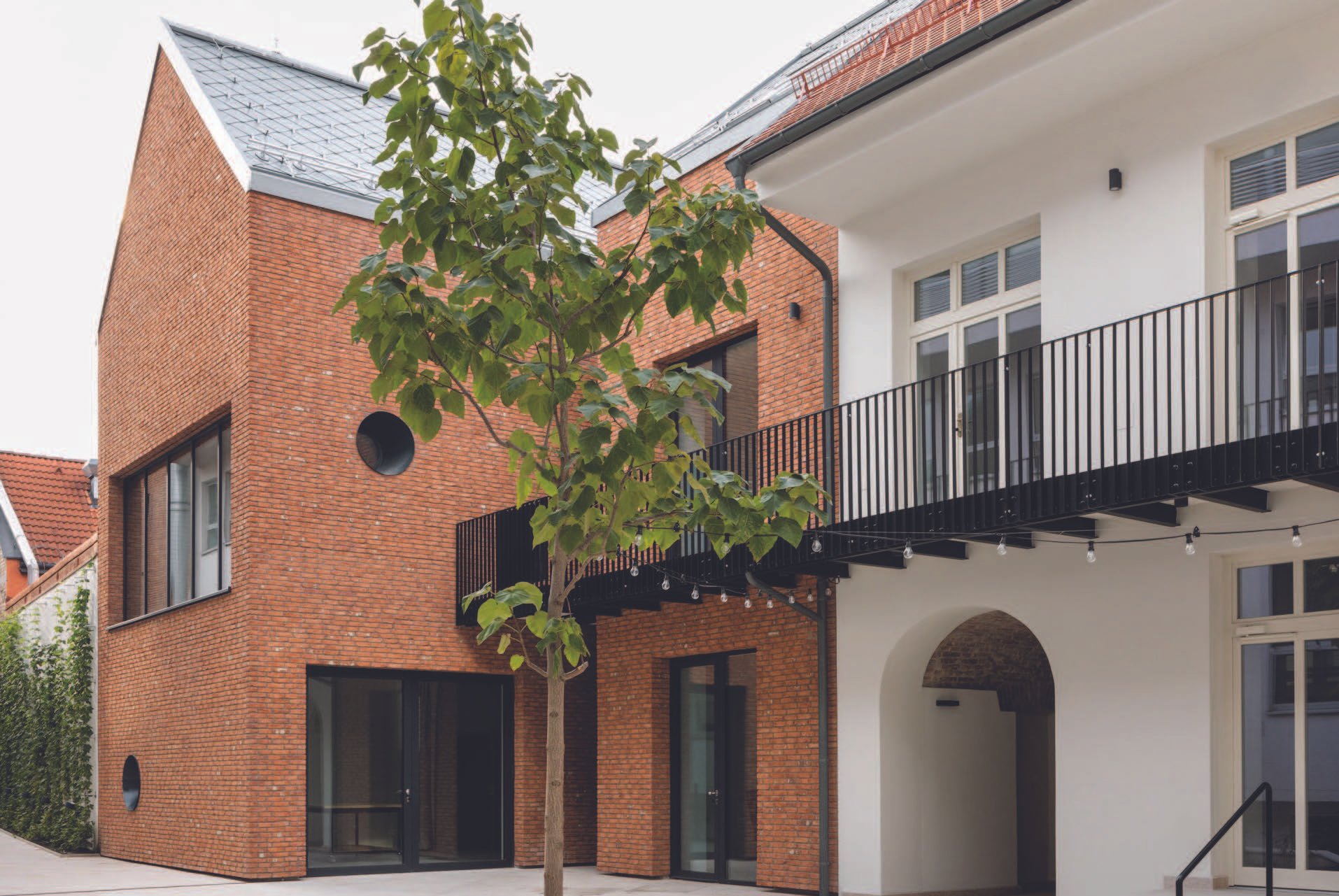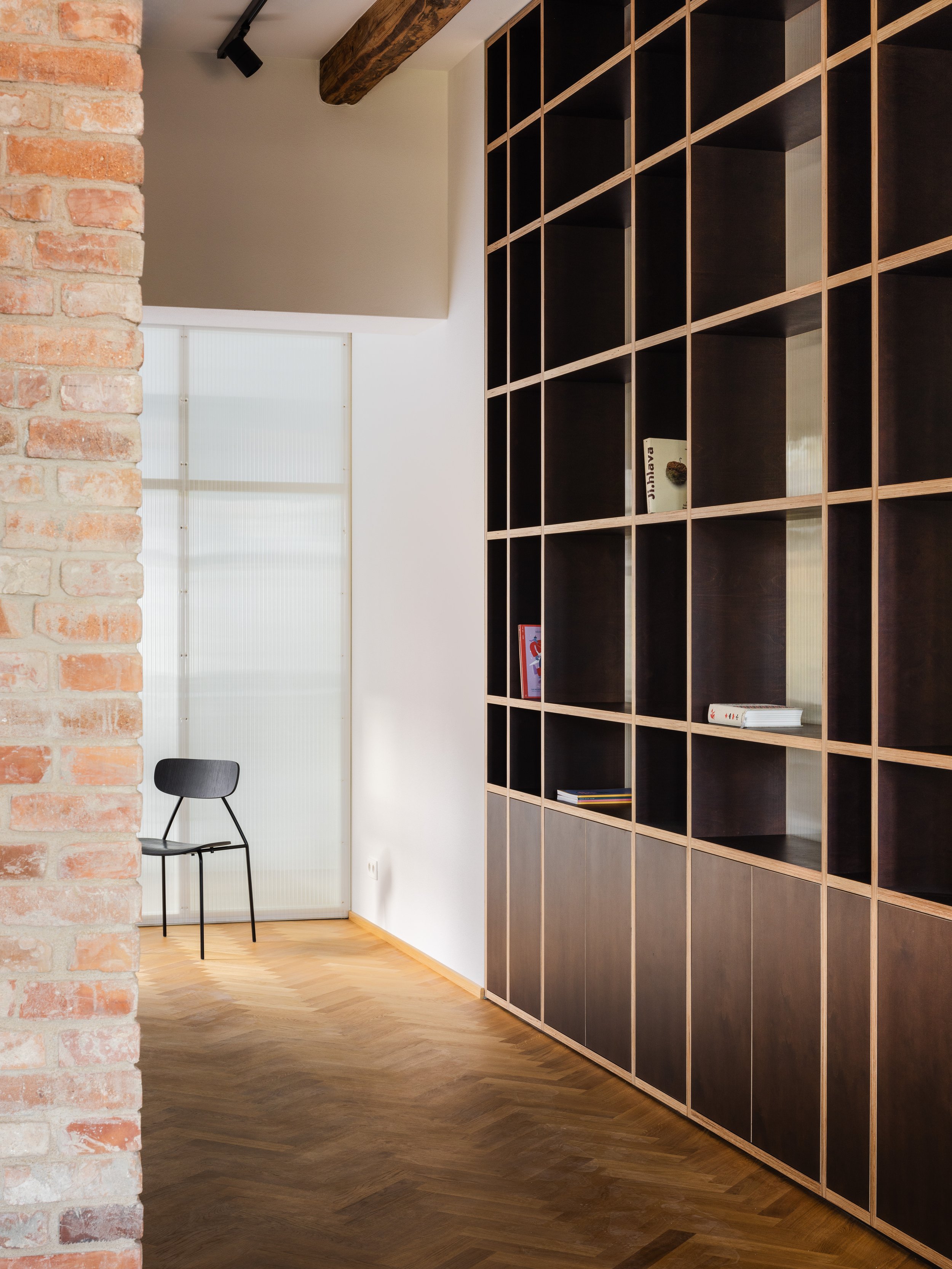Ateliers Nádvorie
Ateliers Nádvorie completes the final stage of the Nádvorie complex, a space dedicated to contemporary culture. Within this proposal a new pedestrian entrance from Pekárska Street and the university park has been established. This multifunctional building encompasses a diverse range of spaces, configured as a creative center with both independent and shared studios, a residential studio structure, an active ground floor with commercial areas, workshops, and administrative facilities for the entire Nádvorie complex.
The reconstructed historical burgher house stands among the sights of Trnava city. It is located within the city's protection zones of cultural heritage. With its originally symmetrical street façade and a U-shaped plan, it has undergone several reconstructions. The underground floor, dating back to the Middle Ages, was progressively extended on.
The Renaissance vault on the ground floor documents the building´s gradual evolution. In the early 20th century, the building was expanded by other upper floors, and its central passage was transformed into an entrance hall with an open staircase. In the second half of the 20th century, parts of both the street and courtyard wings were demolished and later on partially reconstructed. This fragmentation is visible in both the façade and the layout, where the individual additions seem as distinctive separate entities.
The street wing was renovated with a symmetrical façade according to its 20th century design, maintaining newer functional divisions on the ground floor with a passage, entrance, shopfronts, and presenting valuable fragments from previous iterations of the building. The original passage was enhanced by revealing the historical bumpers and an addition of a transparent filling, opening up a view through the entrance hall of the creative center to the courtyard. The indicative reconstruction of the original vault of the passage documents the various stages of the building's life.
The new established connection is also reflected in the layout, where both parts were unified. In addition to the rentable spaces a pop-up space for the creative center is located on the active ground floor. It opens into the passage with a generous window as a paraphrase of the original historical views from the ground floor into the courtyard.
A new intervention was to utilize the attic as a shared studio. For this purpose, a new steel staircase was added, building on the idea of the original open staircase. In the new part of the street wing, a two-story space with a mezzanine was designed for a photographic studio. The recessed floor in the dormer window space facing the courtyard functions as an extension of the shared studio. In addition to a separate small workshop, the attic studio is equipped with a darkroom.
The key space of this building is the communal lounge of the creative center, located in the middle of the street wing on the first floor. This multifunctional space is equipped with flexible furniture and allows for multiple usage scenarios. The entrance area with a library provides access to the new balcony in the courtyard wing, which serves as the main access route to the individual studios.
The courtyard is outlined by the renovated wing, ending with the last preserved historical structure of the Renaissance vault. This vault is left exposed above a passage to the adjacent building, the back of the house of the entire complex. The ground floor is visually open, housing both workshops and rentable spaces. On the upper levels, individual studios are situated.
A new mass and the mass following the original footprint of the historic building form a unique composition. In this case, the frontal continuous balcony is used as a shared communication, visually separating individual masses.
The extension offers additional workshops and studios, which are directly connected within the layout to the existing building. The new transverse courtyard wing is dedicated to an art residency program. Offering a spectrum of facilities such as accommodation, large studios, and more.
Visual connectivity and control are emphasized inside the new structure. The archetypal form of the house is formulated through several setback floors, with the space above them being naturally opened to the roof. This enables the ground floor studio to span up to three floors and open up to the courtyard itself. The studio includes an adjacent workshop, which can easily be visually detached during exhibitions. It’s equipped with a crane for lifting and moving even oversized objects, offering the possibility to work on large-scale projects in-house.
The floor above, with the studio's facilities, is accessible through the balcony. Visually, this open two-story space is connected to the studio. On the adjacent mezzanine, accessible by an interior staircase, is a so-called rest-zone.
Sustainability is one of the main themes of the reconstruction. The project adopted an experimental approach to the newly built courtyard wing, exploring alternative material solutions of prefabricated straw – wooden blocks within a complex context of the historic center and new typological applications. The result is a hybrid structure that works with both traditional masonry as well as lightweight steel frames, where the mentioned prefabricated straw blocks additionally contribute to brace the structure. On top of a low carbon footprint, the material used has an excellent ability to breathe, which is also indicated by the use of clay plaster on the inside and a ventilated facade on the outside.
It is also possible to visually distinguish the new building additions. Their design language follows the other extensions of the complex Nádvorie. The choice to use brick façade cladding refers to the traditional building material of Trnava.
Energy management solutions are directly addressed and emphasized. A system to supply the building throughout the year without the need for additional energy production has been adopted despite the historical heritage character of the reconstructed building offering limited possibilities for an energy-efficient system.
The system consists of geothermal heat pumps. Seven underground wells with a depth of 120m have the ability to accumulate energy in the ground, which can then be used during winter to heat and during summer to cool.
Team: Sadovsky & Architects, Labak
Oliver Sadovský, Viliam Zajíček, Martin Červienka, Michal Marcinov, Barbora Hrmová
Typology: Public architecture
Year: 2023
Location: Trnava, Slovakia
Status: Built
Images: Matej Hakár





















